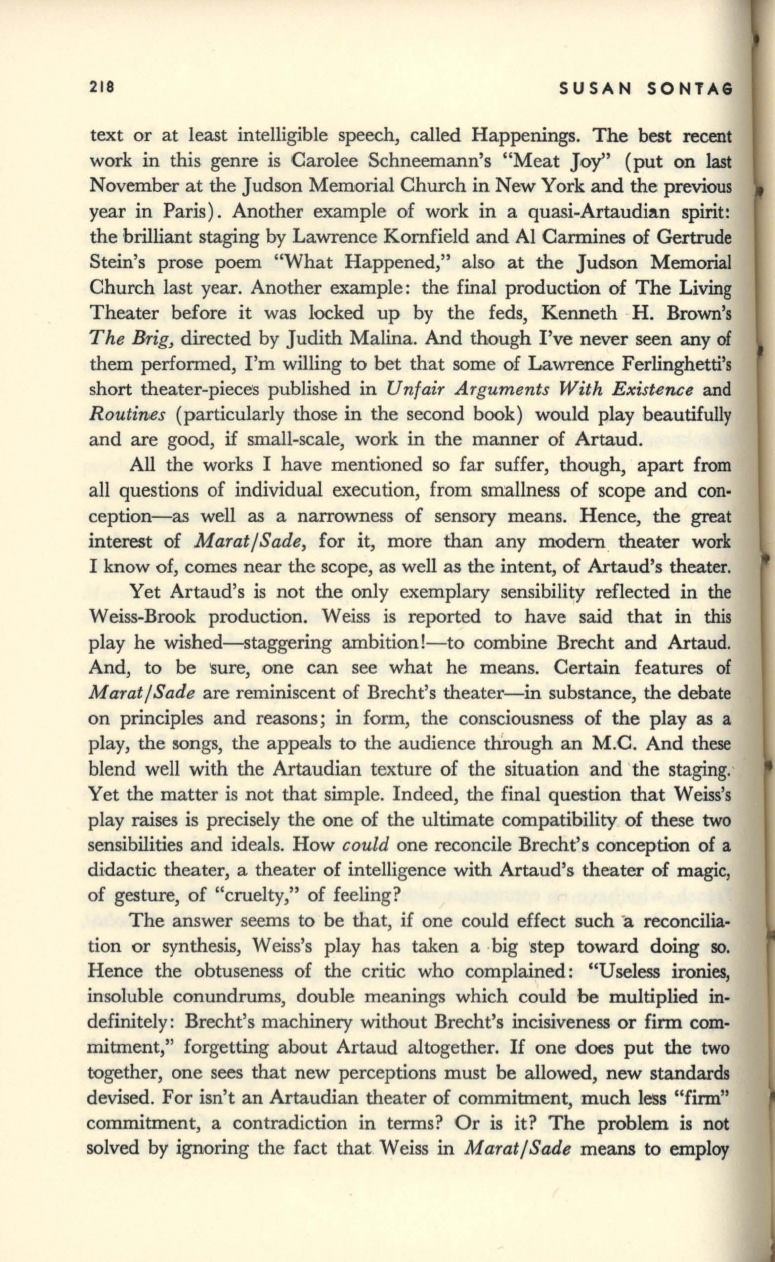
218
SUSAN SONYA6
text or at least intelligible speech, called Happenings. The best recent
work in this genre is Carolee Schneemann's "Meat Joy" (put on last
November at the Judson Memorial Church in New York and the previous
year in Paris). Another example of work in a quasi-Artaudian spirit:
the brilliant staging by Lawrence Kornfield and Al Carmines of Gertrude
Stein's prose poem "What Happened," also at the Judson Memorial
Church last year. Another example: the final production of The Living
Theater before it was locked up by the feds, Kenneth H. Brown's
The Brig,
directed by Judith Malina. And though I've never seen any of
them performed, I'm willing to bet that some of Lawrence Ferlinghetti's
short theater-pieces published in
Unfair Arguments With Existence
and
Routines
(particularly those in the second book) would play beautifully
and are good,
if
small-scale, work in the manner of Artaud.
All the works I have mentioned so far suffer, though, apart from
all questions of individual execution, from smallness of scope and con·
ception-as well as a narrowness of sensory means. Hence, the great
interest of
Marat/Sade,
for it, more than any modem. theater work
I know of, comes near the scope, as well as the intent, of Artaud's theater.
Yet Artaud's is not the only exemplary sensibility reflected in the
Weiss-Brook production. Weiss is reported to have said that
in
this
play he wished-staggering ambition!-to combine Brecht and Artaud.
And, to be sure, one can see what he means. Certain features of
Marat/Sade
are reminiscent of Brecht's theater-in substance, the debate
on principles and reasons; in form, the consciousness of the play as a
play, the songs, the appeats to the audience thTough an M.C. And these
blend well with the Artaudian texture of the situation and 'the staging. '
Yet the matter is not that simple. Indeed, the final question that Weiss's
play raises is precisely the one of the ultimate compatibility of these two
sensibilities and ideals. How
could
one reconcile Brecht's conception of a
didactic theater, a theater of intelligence with Artaud's theater of magic,
of gesture, of "cruelty," of feeling?
The answer seems to be that, if one could effect such -a reconcilia–
tion or synthesis, Weiss's play has taken a ·big step toward doing so.
Hence the obtuseness of the critic who complained: "Useless ironies,
insoluble conundrums, double meanings which could be multiplied in–
definitely: Brecht's machinery without Brecht's incisiveness or firm com–
mitment," forgetting about Artaud altogether.
If
one does put the two
together, one sees that new perceptions must be allowed, new standards
devised. For isn't an Artaudian theater of commitment, much less "firm"
commitment, a contradiction in terms? Or is it? The problem is not
solved by ignoring the fact that Weiss in
Marat/Sade
means to employ


